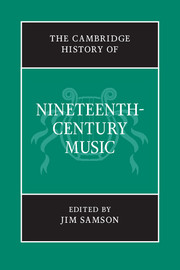Book contents
- Frontmatter
- Part One 1800–1850
- Part Two 1850–1900
- 11 Progress, modernity and the concept of an avant-garde
- 12 Music as ideal: the aesthetics of autonomy
- 13 The structures of musical life
- 14 Opera and music drama
- 15 Beethoven reception: the symphonic tradition
- 16 Words and music in Germany and France
- 17 Chamber music and piano
- 18 Choral culture and the regeneration of the organ
- 19 Music and social class
- 20 Nations and nationalism
- 21 Styles and languages around the turn of the century
- Chronology
- Institutions
- Personalia
- Index
- References
17 - Chamber music and piano
from Part Two - 1850–1900
Published online by Cambridge University Press: 28 March 2008
- Frontmatter
- Part One 1800–1850
- Part Two 1850–1900
- 11 Progress, modernity and the concept of an avant-garde
- 12 Music as ideal: the aesthetics of autonomy
- 13 The structures of musical life
- 14 Opera and music drama
- 15 Beethoven reception: the symphonic tradition
- 16 Words and music in Germany and France
- 17 Chamber music and piano
- 18 Choral culture and the regeneration of the organ
- 19 Music and social class
- 20 Nations and nationalism
- 21 Styles and languages around the turn of the century
- Chronology
- Institutions
- Personalia
- Index
- References
Summary
The historical challenge and a black and white response
If we were applying the title of this chapter to the period 1800–60, and resorting to the nineteenth century’s favoured type of historiography, the ‘great-man theory’, and focusing on new music rather than all the music that was performed, then household names and lists of canonical works would crowd these pages. We would be navigating through Beethoven’s string quartets and piano sonatas, Schubert’s too as well as his piano ‘miniatures’, the Mendelssohn Octet and Songs without Words, Schumann’s piano-chamber music such as the Quintet and his piano cycles from the 1830s that have been performed recurrently to this day – Carnaval (1835) above all, perhaps – and indeed other piano music of that time, most obviously from Chopin and Liszt, both of whom were prolific, as well as being instantly recognised at the time as outstanding. It would be a considerable challenge to provide a representative picture of a period of such scintillating novelty both in the home, in the salon – from which chamber music was emerging on to the professional stage – and in the concert hall, where the piano had established its prestigious position in the closing decades of the eighteenth century.
In the second part of the century, on the other hand, which is our concern here, it is noticeable how the ‘great-man theory’ shows a certain retrenchment, since in both chamber and piano music the scene came to be so radically dominated not by a group of composers of different ages and in different countries, but by one figure, that of Johannes Brahms. This dominance was especially marked after the 1860s, when Brahms had become established as a mature master, and when Liszt had turned from the piano solo largely to other genres. In the 1860s too an aesthetic polarisation had seized European musical life: to put it at its crudest, the agenda was divided between those matters which concerned Wagner’s music dramas (and, admittedly, Verdi’s operas), and those matters, including instrumental music, which did not.
- Type
- Chapter
- Information
- The Cambridge History of Nineteenth-Century Music , pp. 500 - 521Publisher: Cambridge University PressPrint publication year: 2001

